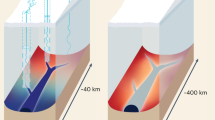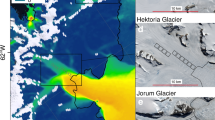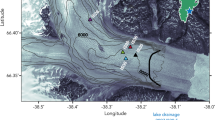Abstract
Seasonal acceleration of the Greenland Ice Sheet is influenced by the dynamic response of the subglacial hydrologic system to variability in meltwater delivery to the bed1,2 via crevasses and moulins (vertical conduits connecting supraglacial water to the bed of the ice sheet). As the melt season progresses, the subglacial hydrologic system drains supraglacial meltwater more efficiently1,2,3,4, decreasing basal water pressure4 and moderating the ice velocity response to surface melting1,2. However, limited direct observations of subglacial water pressure4,5,6,7 mean that the spatiotemporal evolution of the subglacial hydrologic system remains poorly understood. Here we show that ice velocity is well correlated with moulin hydraulic head but is out of phase with that of nearby (0.3–2 kilometres away) boreholes, indicating that moulins connect to an efficient, channelized component of the subglacial hydrologic system, which exerts the primary control on diurnal and multi-day changes in ice velocity. Our simultaneous measurements of moulin and borehole hydraulic head and ice velocity in the Paakitsoq region of western Greenland show that decreasing trends in ice velocity during the latter part of the melt season cannot be explained by changes in the ability of moulin-connected channels to convey supraglacial melt. Instead, these observations suggest that decreasing late-season ice velocity may be caused by changes in connectivity in unchannelized regions of the subglacial hydrologic system. Understanding this spatiotemporal variability in subglacial pressures is increasingly important because melt-season dynamics affect ice velocity beyond the conclusion of the melt season8,9,10.
This is a preview of subscription content, access via your institution
Access options
Subscribe to this journal
Receive 51 print issues and online access
$199.00 per year
only $3.90 per issue
Buy this article
- Purchase on Springer Link
- Instant access to full article PDF
Prices may be subject to local taxes which are calculated during checkout



Similar content being viewed by others
References
Bartholomew, I. et al. Seasonal evolution of subglacial drainage and acceleration in a Greenland outlet glacier. Nature Geosci. 3, 408–411 (2010)
Sundal, A. V. et al. Melt-induced speed-up of Greenland ice sheet offset by efficient subglacial drainage. Nature 469, 521–524 (2011)
Chandler, D. M. et al. Evolution of the subglacial drainage system beneath the Greenland Ice Sheet revealed by tracers. Nature Geosci. 6, 195–198 (2013)
Cowton, T. et al. Evolution of drainage system morphology at a land-terminating Greenlandic outlet glacier. J. Geophys. Res. 118, 1–13 (2013)
Lüthi, M., Funk, M., Iken, A., Gogineni, S. & Truffer, M. Mechanisms of fast flow in Jakobshavn Isbræ, West Greenland: Part III. Measurements of ice deformation, temperature and cross-borehole conductivity in boreholes to the bedrock. J. Glaciol. 48, 369–385 (2002)
Meierbachtol, T., Harper, J. & Humphrey, N. Basal drainage system response to increasing surface melt on the Greenland Ice Sheet. Science 341, 777–779 (2013)
Ryser, C. et al. Sustained high basal motion of the Greenland Ice Sheet revealed by borehole deformation. J. Glaciol. 60, 647–660 (2014)
Doyle, S. et al. Persistent flow acceleration within the interior of the Greenland ice sheet. Geophys. Res. Lett. 41, 899–905 (2014)
Sole, A. et al. Winter motion mediates dynamic response of the Greenland Ice Sheet to warmer summers. Geophys. Res. Lett. 40, 3940–3944 (2013)
Tedstone, A. J. et al. Greenland Ice Sheet motion insensitive to exceptional meltwater forcing. Proc. Natl Acad. Sci. USA 110, 19719–19724 (2013)
Catania, G. A. & Neumann, T. A. Persistent englacial drainage features in the Greenland Ice Sheet. Geophys. Res. Lett. 37, L02501 (2010)
Bartholomew, I. et al. Short-term variability in Greenland Ice Sheet motion forced by time-varying meltwater drainage: implications for the relationship between subglacial drainage system behavior and ice velocity. J. Geophys. Res. 117, F03002 (2012)
Hoffman, M. J., Catania, G. A., Neumann, T. A., Andrews, L. C. & Rumrill, J. A. Links between acceleration, melting, and supraglacial lake drainage of the western Greenland Ice Sheet. J. Geophys. Res. 116, F04035 (2011)
Bartholomaus, T. C., Anderson, R. S. & Anderson, S. P. Response of glacier basal motion to transient water storage. Nature Geosci. 1, 33–37 (2008)
Schoof, C. Ice-sheet acceleration driven by melt supply variability. Nature 468, 803–806 (2010)
Das, S. B. et al. Fracture propagation to the base of the Greenland Ice Sheet during supraglacial lake drainage. Science 320, 778–781 (2008)
Gordon, S. et al. Seasonal reorganization of subglacial drainage inferred from measurements in boreholes. Hydrol. Processes 12, 105–133 (1998)
Hubbard, B. P., Sharp, M. J., Willis, I. C., Nielsen, M. K. & Smart, C. C. Borehole water-level variations and the structure of the subglacial hydrological system of Haut Glacier d’Arolla, Valais, Switzerland. J. Glaciol. 41, 572–583 (1995)
Mair, D. et al. Hydrological controls on pattern of surface, internal and basal motion during three ‘spring events’: Haut Glacier d’Arolla, Switzerland. J. Glaciol. 49, 555–567 (2003)
Hoffman, M. & Price, S. Feedbacks between coupled subglacial hydrology and glacier dynamics. J. Geophys. Res. 119, 411–436 (2014)
Iken, A. & Truffer, M. The relationship between subglacial water pressure and velocity of Findelengletscher, Switzerland, during its advance and retreat. J. Glaciol. 73, 328–338 (1997)
Murray, T. & Clarke, G. K. C. Black-box modeling of the subglacial water system. J. Geophys. Res. 100, 10231–10245 (1995)
Covington, M. D. et al. Quantifying the effects of glacier conduit geometry and recharge on proglacial hydrograph form. J. Hydrol. 414–415, 59–71 (2012)
Dow, C. F. et al. Seismic evidence of mechanically weak sediments underlying Russell Glacier, West Greenland. Ann. Glaciol. 54, 135–141 (2013)
Walter, F., Chaput, J. & Lüthi, M. P. Thick sediments beneath Greenland’s ablation zone and their potential role in future ice sheet dynamics. Geology 42, 487–490 (2014)
Hewitt, I. J. Seasonal change in ice sheet motion due to melt water lubrication. Earth Planet. Sci. Lett. 371–372, 16–25 (2013)
Gulley, J. D. et al. The effect of discrete recharge by moulins and heterogeneity in flow-path efficiency at glacier beds on subglacial hydrology. J. Glaciol. 58, 926–940 (2012)
Joughin, I. et al. Influence of ice-sheet geometry and supraglacial lakes on seasonal ice-flow variability. Cryosphere 7, 1185–1192 (2013)
Howat, I. M., Negrete, A. & Smith, B. E. The Greenland Ice Mapping Project (GIMP) land classification and surface elevation datasets. Cryosphere 8, 1509–1518 (2014)
Gogineni, P. CReSIS Radar Depth Sounder Data http://data.cresis.ku.edu/ (2012)
Iken, A., Echelmeyer, K. & Harrison, W. D. in Ice Core Drilling (eds Rado, C. & Beaudoing, D. ) Proc. Third Int. Workshop on Ice Drilling Technology (Grenoble, 10–14 October) 123–134 (Laboratoire de Glaciology et Géophysique de l’Environment, 1988)
Humphrey, N. & Echelmeyer, K. Hot-water drilling and bore-hole closure in cold ice. J. Glaciol. 36, 287–298 (1990)
Holmlund, P. & Hooke, R. LeB. High water-pressure events in moulins, Storglaciären, Sweden. Geogr. Ann. A 65, 19–25 (1983)
Iken, A. Measurements of water pressure in moulins as part of a movement study of the White Glacier, Axel Heiberg Island, Northwest Territories, Canada. J. Glaciol. 11, 53–58 (1972)
Vieli, A., Jania, J., Blatter, H. & Funk, M. Short-term velocity variations on Hansbreen, a tidewater glacier in Spitsbergen. J. Glaciol. 50, 389–398 (2004)
Werder, M. A., Loye, A. & Funk, M. Dye tracing a jökulhlaup: I. Subglacial water transit speed and water-storage mechanism. J. Glaciol. 55, 889–898 (2009)
Chen, G. GPS Kinematic Positioning for Airborne Laser Altimetry at Long Valley, California. PhD thesis, MIT (1998); http://dspace.mit.edu/handle/1721.1/9680
Mair, D., Nienow, P., Sharp, M., Wohlleben, T. & Willis, I. Influence of subglacial drainage system evolution on glacier surface motion: Haut Glacier d’Arolla, Switzerland. J. Geophys. Res. 107, http://dx.doi.org/10.1029/2001JB000514 (2002)
Mair, D., Sharp, M. J. & Willis, I. C. Evidence for basal cavity opening from analysis of surface uplift during a high-velocity event: Haut Glacier d’Arolla, Switzerland. J. Glaciol. 48, 208–216 (2002)
Anderson, R. L. et al. Strong feedbacks between hydrology and sliding of a small alpine glacier. J. Geophys. Res. 109, F03005 (2004)
Sugiyama, S. & Gudmundsson, H. Short-term variations in glacier flow controlled by subglacial water pressure at Lauteraargletscher, Bernese Alps, Switzerland. J. Glaciol. 50, 353–362 (2004)
Harper, J. T., Humphrey, N. F., Pfeffer, W. T. & Lazar, B. Two modes of accelerated glacier sliding related to water. Geophys. Res. Lett. 34, L12503 (2007)
Howat, I. M., Tulaczyk, S., Waddington, E. & Björnsson, H. Dynamic controls on glacier basal motion inferred from surface ice motion. J. Geophys. Res. 113, F03015 (2008)
Catania, G. A., Neumann, T. A. & Price, S. F. Characterizing englacial drainage in the ablation zone of the Greenland Ice Sheet. J. Glaciol. 54, 567–578 (2008)
McGrath, D., Colgan, W., Steffen, K., Lauffenburger, P. & Balog, J. Assessing the summer water budget of a moulin basin in the Sermeq Avannarleq ablation region, Greenland ice sheet. J. Glaciol. 57, 954–964 (2011)
Paterson, W. S. B. The Physics of Glaciers 3rd edn, 60 (Pergamon, 1994)
Li, V. Estimation of in-situ hydraulic diffusivity of rock masses. Pure Appl. Geophys. 122, 545–559 (1985)
Acknowledgements
This project was supported by United States National Science Foundation grants OPP-0908156, OPP-0909454 and ANT-0424589 (to CReSIS), Swiss National Science Foundation grant 200021_127197, and National Geographic Society grant 9067-12. L.C.A. was also supported by UTIG Ewing-Worzel and Gale White Graduate Student Fellowships. M.J.H. was also supported by NASA Cryospheric Sciences and Climate Modeling Programs within the US Department of Energy, Office of Science. J.D.G. was also supported by an NSF Postdoctoral Fellowship (EAR-0946767). Logistical support was provided by CH2MHill Polar Services. The GPS base station and several on-ice GPS units were provided by the UNAVCO facility with support from the NSF and NASA under cooperative agreement EAR-0735156. The University of Minnesota Polar Geospatial Center, funded under NSF OPP collaborative agreement ANT-1043681, provided WorldView imagery. We thank K. M. Schild, J. A. MacGregor, J. D. Nowinski, B. F. Morriss and others for assistance in the field.
Author information
Authors and Affiliations
Contributions
G.A.C., J.D.G., M.P.L., R.L.H. and T.A.N. designed this study. L.C.A., R.L.H., M.J.H., M.P.L., C.R. and J.D.G. performed the fieldwork. L.C.A. analysed the results and wrote the manuscript. All authors discussed the results and edited the manuscript.
Corresponding author
Ethics declarations
Competing interests
The authors declare no competing financial interests.
Extended data figures and tables
Extended Data Figure 1 Borehole and moulin head and ice-surface velocity over two melt seasons.
a, 2011 measurements from FOXX moulin (blue), borehole 7 (dark red), borehole 6 (pink) and borehole 4 (red). b, 2012 measurements from moulin 3 (navy) and moulin 4 (light blue). c, 2011 ice velocity (black) and bed separation (green) for FOXX. Peak velocity on day 182 is 402.3 m yr−1 (exceeding the y-axis limit). d, 2012 ice velocity and bed separation for FOXX and 25N1 (grey, light green). Peak velocity for FOXX and 25N1 (312 m yr−1 and 337 m yr−1) occurred on day 173. e, f, 6-h averaged air temperature for 2011 and 2012. Grey bars are melt events.
Extended Data Figure 2 Components of vertical motion 2011 and 2012.
a, Components of vertical motion for 2011 at FOXX. Bed parallel motion ( ; black), strain thickening and thinning (
; black), strain thickening and thinning ( ; blue), elevation with measured winter elevation removed (red), and calculated bed separation (green). b, Components of vertical motion for 2012. Colours as in a for FOXX. Lighter colours correspond to components of vertical motion from 25N1.
; blue), elevation with measured winter elevation removed (red), and calculated bed separation (green). b, Components of vertical motion for 2012. Colours as in a for FOXX. Lighter colours correspond to components of vertical motion from 25N1.
Extended Data Figure 3 Modelled hydraulic head and conduit geometry.
a, Moulin 3 head (blue) and supraglacial input (red) are model inputs. Predicted downstream head is calculated from equation (8) (green). Subglacial discharge (black) is calculated as a function of head change and supraglacial inputs. It does not vary significantly from supraglacial input even when a large (∼20 m2) moulin geometry is used. b, Modelled subglacial channel cross-sectional area (black) changes rapidly (grey) during and shortly after expected melt events (grey bars).
Extended Data Figure 4 Seasonal relationship between moulin head and ice velocity for 2012 and 2011.
Moulin hydraulic head and associated ice velocity data plotted every 15 min over the course of the measurement periods for 2011 (a) and 2012 (b). 2011 data are truncated below 543 m by the high elevation of the moulin sensor.
Extended Data Figure 5 Borehole hydraulic heads and ice velocity at GULL during 2011.
Three hydraulic head records (red, yellow, blue) from boreholes located ∼0.5 km from a moulin. Ice velocity from GULL GPS (black), ∼0.75 km south of GULL boreholes.
Source data
Rights and permissions
About this article
Cite this article
Andrews, L., Catania, G., Hoffman, M. et al. Direct observations of evolving subglacial drainage beneath the Greenland Ice Sheet. Nature 514, 80–83 (2014). https://doi.org/10.1038/nature13796
Received:
Accepted:
Published:
Issue Date:
DOI: https://doi.org/10.1038/nature13796
This article is cited by
-
Threshold response to melt drives large-scale bed weakening in Greenland
Nature (2022)
-
The seasonal evolution of subglacial drainage pathways beneath a soft-bedded glacier
Communications Earth & Environment (2022)
-
Warming-driven erosion and sediment transport in cold regions
Nature Reviews Earth & Environment (2022)
-
Diurnal expansion and contraction of englacial fracture networks revealed by seismic shear wave splitting
Communications Earth & Environment (2021)
-
Extreme melt season ice layers reduce firn permeability across Greenland
Nature Communications (2021)
Comments
By submitting a comment you agree to abide by our Terms and Community Guidelines. If you find something abusive or that does not comply with our terms or guidelines please flag it as inappropriate.



